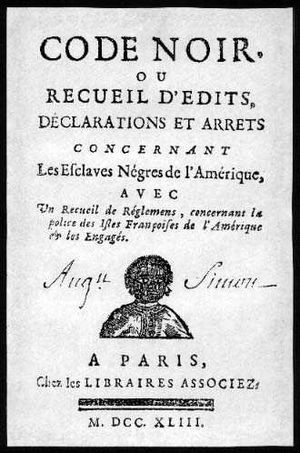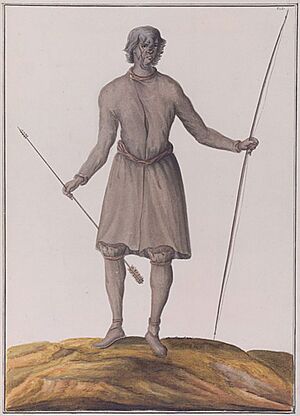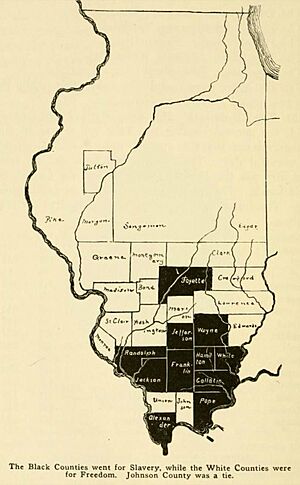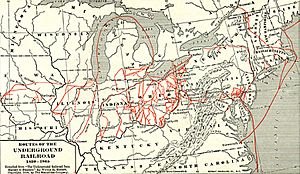History of slavery in Illinois facts for kids



Slavery in Illinois lasted for over 100 years. Even before Illinois became a state in 1818, slavery was already part of the region. France brought African slavery to the Illinois Country in the early 1700s.
People in Illinois continued to own enslaved people during British rule (1763-1783). They also continued after the land became part of the United States in 1783. The Northwest Ordinance of 1787 tried to ban slavery in Illinois and the rest of the Northwest Territory.
However, slavery remained a big problem. It continued when Illinois was part of the Indiana Territory and the Illinois Territory. Some enslaved people were still held in bondage even after Illinois became a state. They were only freed gradually by the Illinois Supreme Court.
So, the history of slavery in Illinois covers many periods:
- French rule (around 1660s-1764)
- British rule (around 1763-1783)
- Virginia rule (around 1778-1785)
- United States Northwest Territory (1787-1800)
- Indiana Territory (1800-1809)
- Illinois Territory (1809-1818)
- State of Illinois (after 1818)
In the first few decades after Illinois became a state, the number of enslaved people slowly went down. Before the American Civil War, Illinois passed a law that made it hard for Black people to move into or live in the state. Near the end of the Civil War, Illinois removed that law. It was also the first state to approve the Thirteenth Amendment to the United States Constitution, which ended slavery across the entire country.
Slavery in Colonial Illinois
During the time when France ruled Illinois, the area was called the "Illinois Country". This region also included parts of what are now Indiana, Wisconsin, and Missouri. The Illinois Country was part of New France, and it followed its slavery laws.
French settlers first brought enslaved Africans to the Illinois Country around 1720. They came from Saint-Domingue (which is now Haiti). This was done under the rules of the Code Noir. This code set the legal conditions for slavery in the French colonial empire. It also limited what free Black people could do.
Some old stories say that Philip François Renault brought 500 enslaved Black people to Illinois in 1721. But it's more likely he brought far fewer. For example, a document from 1720 shows that a group of Jesuits owned 16 to 18 enslaved people. After trying to mine lead without success, Renault started a farm in St. Philippe, Illinois, in 1723. He used enslaved people to grow crops there.
Slavery continued after Britain took control of the eastern Illinois Country in 1763. This happened after the French and Indian War. At that time, about 900 enslaved people lived in the territory. However, some French settlers took at least 300 enslaved people with them when they moved west of the Mississippi River into what would become Missouri.
Slavery in U.S. Territories
Slavery continued even after the American Revolutionary War. The land was then given to the United States. The first law against slavery was the Northwest Ordinance of 1787. This law banned slavery in the Northwest Territory.
However, local laws and practices still allowed people to be held in bondage in different ways. Governors like Arthur St. Clair and Charles Willing Byrd supported slavery. They did not enforce the ban. When the Indiana Territory (which included future Illinois) was formed in 1800, people living there asked the United States Senate to allow slavery. A plan was suggested to free enslaved males born in Illinois at age 31 and females at age 28. Enslaved people born in the South would remain enslaved for life. But this plan was never approved.
The Illinois Territory, created in 1809, kept the Black Code from the Indiana Territory. These codes limited the rights of free Black people. They had to carry papers to prove they were free. Slave owners could keep their workers enslaved for a very long time, sometimes 40 to 99 years. They would threaten to sell them if they refused to sign these agreements. Also, free Black people could be kidnapped and sold in St. Louis or other states where slavery was legal.
The Illinois Salines was a large salt-making business run by the U.S. government near Shawneetown. It was one of the biggest businesses in the Illinois Territory. Between 1,000 and 2,000 enslaved people were rented from their owners in slave states. They were forced to work continuously to keep the salt kettles boiling.
Slavery During Illinois Statehood
Illinois' first state constitution in 1818 said that slavery should not be "thereafter introduced." But slavery was still allowed in the early years of Illinois statehood. The constitution did not have a rule that would stop an amendment from being added to allow slavery.
However, many people worked hard to stop this. Religious leaders like Morris Birkbeck and Peter Cartwright, publisher Hooper Warren, and politicians like Edward Coles and Daniel Pope Cook were involved. Because of their efforts, Illinois voters in 1824 rejected a plan for a new meeting to change the constitution. This meeting could have made slavery fully legal.
People who hunted enslaved people from Missouri would come to Illinois. They wanted to catch enslaved people who had escaped. They also kidnapped free Black people to sell them into slavery. This happened partly because Illinois' laws made the Black Code stricter. It said that escaped enslaved people who were caught would have more time added to their forced labor.
The next year, a law stopped Black people from being witnesses in court cases against white people. Two years later, Black people were stopped from suing for their freedom.
Despite these laws that allowed slavery in practice, the Illinois Supreme Court began to make decisions that slowly freed enslaved people in Illinois.
- In 1825, the court decided that for a work contract to be valid, both people had to agree and sign it.
- Later, the court ruled that forced labor contracts would not be enforced unless they followed all Illinois laws. This included being registered within 30 days of entering the state.
- In 1836, the court decided that children of registered enslaved people brought into the state were free. They could only be forced to work until they were 18 or 21 years old, depending on their gender.
- In 1843, the court said that if any trickery happened when a forced labor contract was signed, the contract was not valid.
- Finally, in 1845, the court ended the allowance of slavery even for the descendants of former French enslaved people. It ruled that descendants of enslaved people born after the 1787 Northwest Ordinance were born free.
Illinois residents also helped enslaved people escape to freedom using the Underground Railroad. Major routes started in towns along the Mississippi River like Chester, Alton, and Quincy, leading to Chicago. Other routes went from Cairo to Springfield, Illinois or along the Wabash River.
The Illinois' Constitution of 1848 banned slavery. Section 16 of its Declaration of Rights stated: "There shall be neither slavery nor involuntary servitude in the State, except as a punishment for crime whereof the party shall have been duly convicted."
However, later laws led to some of the strictest Black Codes in the country until the American Civil War. The Illinois Black Code of 1853 made it illegal for any Black person from outside the state to stay for more than ten days. Black people who stayed longer could be arrested, fined, forced to work to pay the fine, or sent away. This law caused Black communities in Illinois to organize politically. They held the first statewide "Colored Convention" in October 1853 to protest the law.
The Black Code was removed in early 1865, the same year the Civil War ended. At that time, Illinois also became the first state to approve the Thirteenth Amendment to the United States Constitution, which ended slavery across the nation.



